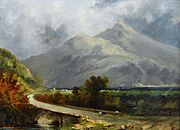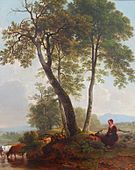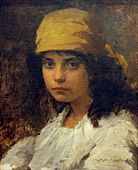Hickory Museum of Art facts for kids
| Established | February 4, 1944 |
|---|---|
| Location | 243 Third Avenue NE Hickory, NC 28601 |
| Director | Clarissa Starnes |
| Website | hickoryart.org |
The Hickory Museum of Art (HMA) is a cool art museum in Hickory, North Carolina. It shows off amazing art from the 1800s, 1900s, and 2000s. You can see many different kinds of American art here. The museum also has a special display of Southern contemporary folk art. This art is made by self-taught artists from the area. The Hickory Museum of Art is North Carolina's second-oldest museum. It first opened its doors in 1944.
Contents
What is Museum Accreditation?
The Hickory Museum of Art first earned a special national award in 1991. This award is called "accreditation" and comes from the American Alliance of Museums. It means the museum meets very high standards. In 2014, the museum earned this award again.
Accreditation is the highest honor an American museum can get. Out of about 35,000 museums in the country, only 1,033 are currently accredited. To get this award, a museum studies itself for a year. Then, a team of experts visits to check everything. They report to a special group of museum professionals.
The Museum's Story
In the early 1940s, Hickory was a growing city with about 15,000 people. It was an important cultural spot in the region. Paul Whitener, who became the museum's first director, believed the city needed a place for visual arts.
In September 1943, with help from local businessman A. Alex Shuford Jr., Whitener gathered a group of citizens. They talked about starting an art group. Even without a collection or a building, the Hickory Museum of Art Association held its first art show in November 1943. It was in an empty office building downtown. About 600 people came to see the art.
In February 1944, North Carolina Governor Clyde Hoey officially recognized the museum. This happened at a ceremony in the Old Hickory Hotel. The Hickory Museum of Art was officially opened four months later. Paul Whitener was chosen as its first Director.
Where the Museum Has Been
Within a year of opening, the museum had bought a dozen paintings. It moved into the W.W. Bryan house on Hickory's Third Avenue. This was its home for the next 14 years.
In 1960, the museum moved again. It went to the old office building of Shuford Mills. This new space helped the museum grow its programs. They started art classes and expanded their yearly School Art Show.
By 1984, the museum needed an even bigger place. They had raised $650,000 for this goal. Buck Shuford, from the Shuford family who had always supported the museum, led a big effort. He wanted to turn the old Hickory High School building into an arts center. His campaign raised $2.6 million to buy and fix up the building.
Two years later, the newly renovated building opened. It was called the Arts & Science Center of Catawba Valley. This became the museum's new permanent home. Today, this building is part of the SALT Block. The SALT Block is a cultural arts complex. It also houses the Catawba Science Center, Hickory Choral Society, Patrick Beaver Library, United Arts Council, and Western Piedmont Symphony.
What Art Can You See?
The museum's first painting was bought in March 1944 for $140. It was called Burke Mountain, Vermont by Frederick Ballard Williams. The art collection grew quickly after that. Paul Whitener used his art connections in New York City to buy affordable American art. Many New York artists, including Whitener's friend Wilford Conrow, spent summers in North Carolina. They became interested in the museum and some even gave their art to it.
In 1954, the museum received many important artworks. These came from the collection of Hobart Nichols, a famous artist. The collection included pieces by Thomas Cole, Asher Brown Durand, John Frederick Kensett, Worthington Whittredge, Edward Henry Potthast, and Robert Lewis Reid.
Today, the museum has about 1,500 art objects. These include paintings from the Hudson River School, American art pottery, Glass Art, High-Speed Photography, and art by local artists.
Paul Whitener wanted the museum to show "all the arts and crafts of the upper Piedmont region of North Carolina." The museum also celebrates the folk art traditions of the Southern United States. This includes art from North Carolina and the Catawba Valley region. The third floor of the museum is dedicated to a long-term folk art exhibition.
In 2004, the museum received over 150 contemporary Southern folk art objects. These came from the collection of Allen and Barry Huffman, who live in Hickory. This was the largest collection the museum had ever received. It has grown even more since then. The artists in this collection are usually self-taught. They are not part of the main art world but are important to the region's history. Some of these artists include James Harold Jennings, Richard Burnside, Miles Carpenter, Raymond Coins, Abraham Lincoln Criss, Minnie Adkins, Howard Finster, Russell Gillespie, and Minnie Reinhardt. You can also see traditional Catawba Valley Pottery, including famous "face jugs."
- Selections from the Permanent Collection
-
Attributed to Thomas Cole, Landscape
-
Asher Brown Durand, Pastoral Scene
-
William Merritt Chase, Portrait of a Young Woman




